When you search for "onion recall," you're likely concerned about food safety and whether onions in your kitchen might be contaminated. Understanding current and historical onion recalls is crucial for protecting your family from foodborne illness. This guide provides verified information about recent onion recall events, how to identify affected products, and practical steps to keep your kitchen safe.
Understanding Onion Recalls: Why They Happen
Onion recalls typically occur due to contamination risks, most commonly from Salmonella bacteria. Unlike many produce items, onions' low moisture and acidic nature allow salmonella to survive for extended periods—up to three months at room temperature. The 2021 outbreak traced to red, white, yellow, and sweet onions imported from Mexico affected consumers through multiple exposure pathways, including raw consumption and cross-contamination in kitchens.
Recent Onion Recall Timeline
The most significant recent onion recall unfolded through these critical stages:
- July 2021: CDC begins investigating multi-state salmonella outbreak linked to onions
- August 4, 2021: First voluntary recall issued by ProSource Inc. for red onions
- August 18, 2021: Recall expanded to include yellow and white onions
- November 2, 2021: Thomson International issues comprehensive recall of all onion varieties shipped since May 2021
- December 2021: CDC declares outbreak over after confirming 1,040 illnesses, 178 hospitalizations, and no deaths
How to Identify Potentially Affected Onion Products
During active recalls, identifying affected products requires careful attention to labeling details. The following table shows key identification markers from the 2021 recall:
| Product Type | Brands Affected | Identification Markings | Best Practice for Consumers |
|---|---|---|---|
| Red Onions | Brands Del Valle, Onions 55, and others | "PROSOURCE" or "THOMSON INTERNATIONAL" on packaging | Discard if purchased between May-August 2021 |
| Yellow Onions | Multiple store brands | "THOMSON" sticker or bulk without labeling | Check with retailer if uncertain about origin |
| Sweet Onions | Vidalia, Walla Walla, Texas Sweet | May have been mislabeled as other varieties | When in doubt, throw it out |
Health Implications of Contaminated Onions
Salmonella contamination from onions presents unique challenges compared to other produce. The bacteria can transfer easily to kitchen surfaces, cutting boards, and other foods through cross-contamination. Symptoms typically appear 6 hours to 6 days after consumption and include:
- Diarrhea (often bloody)
- Fever and chills
- Severe abdominal cramps
- Nausea and vomiting
High-risk populations—including children under 5, adults over 65, and immunocompromised individuals—face greater likelihood of hospitalization. The CDC reports that approximately 17% of those affected in the 2021 onion recall required hospitalization.

Practical Steps If You Suspect Contaminated Onions
If you discover potentially recalled onions in your kitchen, follow these evidence-based steps:
- Immediate removal: Place onions in a sealed plastic bag before discarding to prevent cross-contamination
- Surface sanitation: Clean all surfaces, cutting boards, and utensils that contacted the onions using a bleach solution (5 tablespoons per gallon of water)
- Hand hygiene: Wash hands thoroughly with soap and warm water for at least 20 seconds after handling
- Monitor health: Watch for symptoms for up to 7 days after potential exposure
- Report: Contact your local health department if you believe you've consumed recalled product
Preventing Future Onion-Related Food Safety Issues
While you can't prevent recalls from happening, you can reduce your risk through proper handling practices:
- Always check the FDA's food recall page when hearing about potential outbreaks
- Store onions separately from other produce to minimize cross-contamination risk
- Clean your hands and surfaces before and after handling raw onions
- Consider cooking onions thoroughly, as heat destroys salmonella bacteria
- Keep receipts that show produce purchase dates and origins
Staying Informed About Future Onion Recalls
Food safety information evolves rapidly during recall events. The most reliable sources for current information include:
- FDA's Foodborne Outbreak Investigations page
- CDC's Salmonella Information resources
- Your state or local health department's food safety alerts
- USDA's Food Safety and Inspection Service updates
Remember that legitimate food recalls never ask for payment or personal information. Scammers sometimes exploit food safety concerns, so verify all recall information through official government channels.
Frequently Asked Questions
How long does salmonella survive on onions?
Salmonella can survive on onions for up to three months at room temperature. The low moisture content and slightly acidic nature of onions create conditions where the bacteria can persist longer than on many other produce items. Proper cooking destroys salmonella, but raw contaminated onions remain a risk throughout their shelf life.
Can cooking eliminate salmonella from recalled onions?
Yes, thoroughly cooking onions to an internal temperature of 165°F (74°C) will destroy salmonella bacteria. However, during active recalls, health authorities recommend discarding affected products rather than attempting to cook them, as cross-contamination can occur during preparation before cooking.
How do I know if my onions are from a recalled batch?
Check for specific labeling information including brand names, packaging details, and date codes. During the 2021 recall, affected onions often had "PROSOURCE" or "THOMSON INTERNATIONAL" on packaging. When purchasing onions, keep receipts that show the purchase date and store location, which can help determine if your product was part of a recall.
Are organic onions less likely to be recalled?
No, organic certification doesn't prevent contamination risks. Both conventional and organic onions can be affected by salmonella outbreaks. The 2021 recall included both conventional and organic onion products. Food safety depends on growing, harvesting, and handling practices rather than organic status.
What should I do if I consumed recalled onions but have no symptoms?
Most healthy adults recover from salmonella exposure without complications. However, monitor for symptoms for up to 7 days after consumption. If you're in a high-risk group (young children, elderly, immunocompromised), contact your healthcare provider even if symptoms haven't appeared. Keep documentation of the product in case health authorities need exposure information for outbreak tracking.











 浙公网安备
33010002000092号
浙公网安备
33010002000092号 浙B2-20120091-4
浙B2-20120091-4